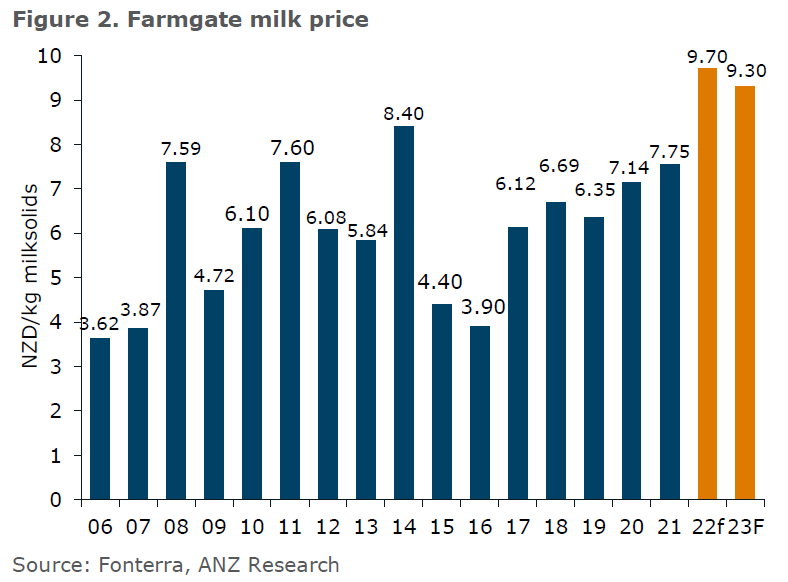
Economists, who believed not so long ago that dairy product prices would drop back next year, are now increasingly picking farmgate returns to stay high into 2023.
ANZ agricultural economist Susan Kilsby has hiked her forecast for the farmgate milk price in 2022-23 season (starting in June 2022) to 9.30 per kilogram of milk solids from just $8.40 previously. And she's also lifted her forecast for the current season to a now market-leading $9.70.
Giant dairy co-operative Fonterra recently pushed its forecast Farmgate Milk Price range up to $9.30-$9.90 per kilogram of milk solids, giving a 'midpoint' price (at which advance payments to farmers are made) of $9.60. The current record high price for a season is the $8.40 that was paid in 2014, so whatever happens between now and the end of the season this year's payment will smash that record.
Arguably the bigger news though is that the current super-high dairy prices are now being seen as likely to stay with us for longer - hence the thought that next year's payout could be a bumper one too.
"...We expect milk prices to remain at elevated levels next season," Kilsby said.
"We expect dairy commodity prices to remain at high levels at the beginning of the season but think it is unlikely prices will stay at such lofty levels as the season wears on."

Kilsby said global risks were "highly elevated" at present, which is driving uncertainty.
"The Ukraine situation is adding fuel to what is already an overheated commodity market. Oil prices have skyrocketed but continue to seesaw on headlines on how the war is progressing. Energy commodities were in tight supply before the invasion and the supply situation is now at least a lot less certain. High gas prices are pushing up fertiliser prices, which in turn is pushing up the prices of grain and food in general. The cost of producing milk is rising, particularly in the Northern Hemisphere, where indoor farming systems mean much greater exposure to high prices for fertiliser, grain and fuel."
The lift in the price of producing milk had already resulted in a reduction in production in some of the main dairy-exporting regions, including the United States, Kilsby said.
"It now seems very unlikely that there will be a meaningful increase in production anywhere in the world over the next six months. This eliminates much of the downside risk for dairy commodity prices in the short-term."
However, dairy commodity export prices are nearing record levels and when expensive freight is added into the equation, combined with relatively subdued economic conditions, "it appears only a matter of time" before there is some reduction in dairy demand.
"At this point it does look like we will be commencing the 2022-23 season with dairy commodity prices at a very strong level. It is debatable how long prices will hold at such elevated levels but there is certainly nothing obvious on the horizon to derail prices immediately. But we are operating in a highly unusual environment where economic risks are certainly high and markets are not always behaving as they have in the past."
In summary, Kilsby said the farmgate milk prices for this season is now certainly going to be a record price.
"Returns are also expected to remain elevated next season, but there is a much higher degree of risk in next season’s milk price. Not just because it is a whole season later, but also because of the global uncertainty we are seeing at present. Additionally, while high milk prices are generating higher income levels costs are also rising rapidly – particularly fertiliser, labour and feed costs."
14 Comments
$9/kg MS at the farmgate.. hmm, whats a 1kg block of tasty cheese at a NZ supermarket going to hit. $25?
The homebrand tasty cheese is priced at $17.90 at my local Countdown, so yeah, $25 seems to be just around the corner. The Woolworths equivalent is $10.
Too bad you don't buy iron ore at supermarkets or else people across the Tasman would have to pay dearly for their purchases of red dirt at supermarkets.
Don't worry, these guys have never been right. The only thing I know for sure right now is that the price won't be anywhere near $9kg/ms. Forecasts at this time of year are about as accurate as throwing darts at a number board.
Therefore they do not need cheap compliant immigrant labor and can afford to pay wages high enough to attract Kiwis to work the long hard hours that they require.
Chris M
Where is your data that says immigrant farm staff are cheap as you comment ?
Fact is you are wrong.
Why are you not focusing on $1 million a day profit that supermarkets suck out consumers pockets ?
I agree. It's usually horticulture requires cheap hands to pluck fruit seasonally. Most city-dwellers can't tell the difference!
Dairy farming pays at the top-end of the agricultural sector; an experienced farm assistant could make up to 80k (Careers NZ) with more opportunities to upskill and move further up the ranks.
How many hours a week do they have to work for that? How many days a week do they have to work for that? How many hours a year do they have work for that? What are the penal rates for long days? What are the penal rates for long weeks?
Bottom line is that if you pay a good wage for the work you should have no trouble getting kiwi staff. Wages in NZ are pretty low by world standards you should not be having any problems. Your competition is pretty weak.
I'll bite. Firstly no industry is immune - everyone struggles to attract people at the moment, whether it is Ag, Hort, IT, Banking etc etc.
Our team members work 2200 hours per year on average. or 45 hours per week with 4 weeks holiday. It is seasonal so they work longer hours in the Spring - 8-12 hours per day and they are now enjoying their summers milking OAD and working about 3-5 hours per day and even less once they dry off in Autumn. All of our staff are more than happy with that trade-off and love their summers and often holiday over seas in June when hours are very minimal.
They also get a nice house to themselves (at very cheap rent $120 to $200) and many of our team have bought rental properties to help them get ahead since they are provided a house to live in. This, I believe, is a very under considered advantage to farming that people don't think about particularly in todays housing market.
We provide a heap of training from financial to leadership, H&S, to farming & animal wellbeing and they have near limitless opportunity to grow either with us or in the industry.
People with no experience are starting at 60-65k and our top end staff are on 120k+ plus they get meat, have plenty of room for vege gardens, don't have to buy fuel to travel to work, get a lot of their work clothing & boots provided.
Your milk payment has just gone up considerably, so you can afford to pay more.
When I was a high school kid I worked as a roussey in a shearing gang. I was payed 10 shillings per hour. In today's money that is close to $80/hour. You have a wee way to go yet. And I understand why you would balk at that. For many they could not afford such high wages because of the massive loans that you have on your farms. The reality is that if you had to pay wages that were sufficient to attract Kiwis, you might struggle to pay the bank. Bottom line is that the farms are not worth what is being paid for them and by allowing in cheap overseas labor, the government is underwriting a farm price ponzie scheme similar to our housing situation. Once the banks are a large beneficiary. Time to break the silly cycle and a period of high milk payments is the best time.
I regret trying to reason with someone displaying your sense of logic...
Chris-M: Bollocks to your $80/hr. There were 20shillings in a pound, so 10 shillings is only half that value. Using the RBNZ wages inflation calculator at no time did 20shillings equal $80 in 2021 NZD. One pound did, at various times in history, but not 10 shillings. The wages inflation calculator is not always the same as CPI inflation calculator.
Thanks for that. You are right. I went back and checked my figures. I used the Reserve bank inflation calculator which has dedicated wage figures available. I typed in $1 (1 pound = $2). When I then entered the dates it reinterpreted that 1 dollar as one pound. Hence an error by a factor of two. Having said that $40 an hour in todays money is a lot for a kid. An experienced adult would surely be worth getting close to twice as much.
I just looked on trademe jobs and seek and I could not find a single ad for a dairy farm worker in Northland....... do they advertise elsewhere?
Yes
Farmsource jobs.

We welcome your comments below. If you are not already registered, please register to comment.
Remember we welcome robust, respectful and insightful debate. We don't welcome abusive or defamatory comments and will de-register those repeatedly making such comments. Our current comment policy is here.